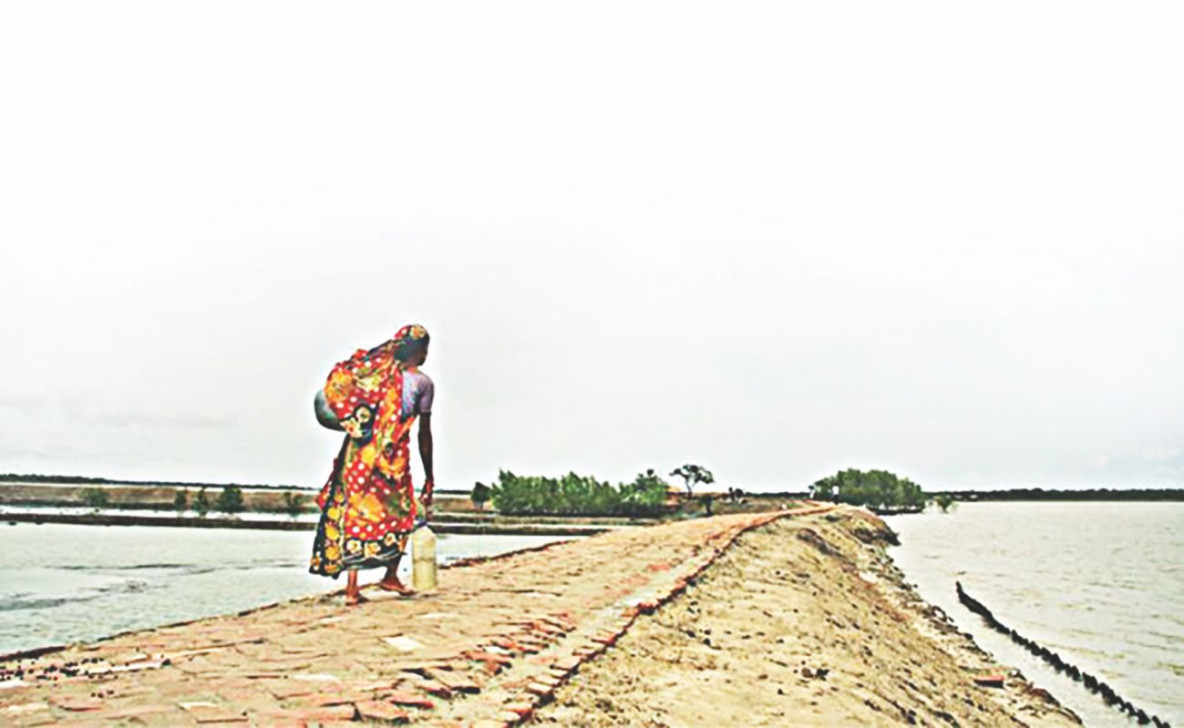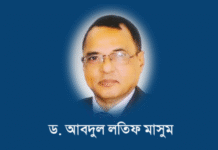
AST week, I visited some villages in Shyamnagar Upazila under Satkhira and Dacope Upazila under Khulna. During my visit, I talked to Aleya Begum, a 25-year-old woman who lives at the Sutarkhali Union of Dacope. Waking up before dawn every day, Aleya Begum walks to a water plant about five kilometres away to collect fresh drinking water for her six-member family. It will be midday or even later before she returns home. Without this strenuous journey through an uneven path, and without any path to the plant near Sutarkhali Union Parishad, where pond water is treated, there will be no water for cooking and drinking.
Though the walk itself takes two hours, Aleya says she has to queue up for much of the day to get her turn at the water point. This is a daily routine for thousands of people in Sutarkhali and many unions in the coastal districts including Khulna, Satkhira and Bagerhat in southwest Bangladesh.
It is well known that scarcity of drinking water is acute as freshwater aquifers are not available at suitable depths and the surface water is highly saline in southwest Bangladesh. Households are mainly dependent on a few water technologies and sources including Rain Water Harvesting (RWH), Pond Sand Filters (PSF), Reverse Osmosis (RO), and deep tube-wells and pond water for drinking purposes. But the technologies are expensive and barely affordable for the poor communities. Thus, they drink poisoned water from local sources.
Therefore, individuals in these areas often suffer from waterborne diseases. The World Health Organization (WHO) estimates that four out of five cases of child mortality in the areas are related to contaminated drinking water. Lack of access to clean water leads to increased rates of disease, lower attendance rates at school and work, and a drastic reduction in overall life quality. According to a 2012 study by the Department of Public Health Engineering (DPHE), 61 percent of the coastal region’s population face serious health issues. Without enough fresh water, women and young girls are amongst the worst sufferers. As women drink less water, high blood pressure and heart and kidney diseases are common, which affect the health of new-born babies.
In addition, most people in the region are unaware of the increasing salinity and its many implications. According to a new study carried by DPHE and the Institute of Water Modelling, 84 percent of people don’t know about salinity in groundwater in the country’s coastal region.
During the devastating Cyclone Aila in 2009, almost all the freshwater sources in southwest Bangladesh were destroyed, and there has been little progress ever since. In most places, tube-wells don’t work because of salinity in the shallow and deep aquifer levels. The embankments are eroded and groundwater sources are flooded; therefore, about 70 percent of people in the region depend on pond water for drinking and domestic uses.
Due to the impact of climate change, the daily struggles of thousands like Aleya Begum are being exacerbated. Over the past 25 years, salinity intrusion in Bangladesh has increased by about 26 percent with the affected areas expanding each year. According to a 2014 study by World Bank, climate change is likely to further increase river and groundwater salinity dramatically by 2050 and exacerbate shortages of drinking water and irrigation in the southwest coastal areas, adversely affecting the livelihoods of at least 2.9 million poor people in a region where 2.5 million people are already struggling with a lack of water. As a result, as water sources dry up and demands increase, women like Aleya Begum are forced to walk further and further to provide water for their family.
Even nearly a decade after Aila, the government of Bangladesh and non-government organisations active there are yet to restore freshwater sources in the country’s coastal belt. This is primarily because of lack of water flow in rivers (which contributes to the rise of salinity), remoteness of the areas, and lack of sustainable and joint initiatives. The water plants built by different institutions become dysfunctional within a short span of time due to extreme level of salinity and lack of regular maintenance. Awareness of local people is also an issue.
Recently, Nobo Jatra, a USAID-funded project, conducted a study on exploring options for surface and ground water in Khulna and Satkhira districts, coming to the conclusion that no single option or technology could be recommended for providing safe water in salinity-prone areas. Determining what technology is appropriate for a particular area depends on the local situation. Exploring tube-well technology would be the first priority if suitable aquifer is available; otherwise, surface water or treatment technologies could be utilised.
The study has shown that deep tube-well is the most preferable option where suitable deep aquifer with low-salinity water is available. But suitable groundwater is absent in most of the places, and quite expensive too. Pond Sand Filter (PSF) is a promising option for community water supply where suitable pond is available. But maintenance and management are an issue where mass mobilisation is a prerequisite. For the existing PSF, pond re-excavation, cleaning, lime mixing on each edge side for protection of saline water intrusion is needed. Though it is seasonal and expensive for the poor and extreme-poor households, Rain Water Harvesting (RWH) system appears to be a suitable option both at household and community levels.
In the last decade, the government had taken various steps to resolve water problems in the coastal region. Dredging of Gorai River is one of them. It is expected that the flow of river water will increase in the coastal region, and freshwater sources will be restored, eventually resolving the salinity problem. Also, a combination of household and community-based options could be suitable for year-round water supply while community-based options need regular maintenance. In addition to installation of water supply facilities, it is necessary to make the residents aware of proper operation and maintenance of the facilities.
Bangladesh’s southwest is surrounded by a number of rivers. But due to the extreme level of salinity and lack of long-term sustainable solutions, people in the coastal belt are suffering from scarcity of potable water. Their sufferings remind us of a verse from The Rime of the Ancient Mariner by Samuel Taylor Coleridge: “Water, water, everywhere. But not a drop to drink.”
Mohammed Norul Alam Raju is the Technical Program Director of Nobo Jatra at World Vision Bangladesh.
Source: The Daily Star.









